 Long Answer Type
Long Answer Type(a) The diagram below represents a stage of a cell division. Study the same and answer the questions which follow: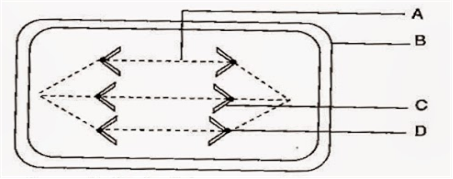
(i) Identify the stage of cell division.
(ii) Name the parts labelled A, B, C and D.
(iii) What is the unique feature observed in this stage?
(iv) Where does this type of cell division usually occur?
(v) How many daughter cells are formed from this type of cell division?
(vi) Is the dividing cell shown a plant or an animal cell? Give a reason to support your answer.
The diagram below represents a structure found in a leaf. Study the same and answer the questions which follow: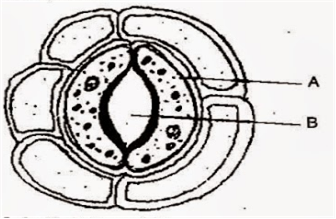
(i) Name the parts labelled A and B.
(ii) What is the biological term for the above structure?
(iii) What is the function of the part lallelled A?
(iv) Mention two structural features of A which help in the function mentioned in (iii) above.
(v) Where is this structure likely to be found in leaf?
(vi) The above structure helps In the process of transpiration. Explaln the term transpiration.
(vii) How many other cells are found surrounding this structure as seen in the diagram?
The diagram shows a section of the human brain. Answer the questions which follow: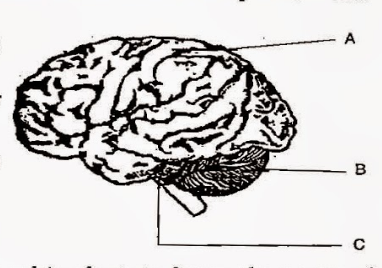
(i) Name the parts labelled A. B and C.
(ii) Give the main function of each of the parts A. B and C.
(iii)Name the three protective membranes covering the brain.
(iv)Name the basic unit of the brain.
The diagram below represents the structure found in the Inner ear. Study the same and then answer the questions which follow: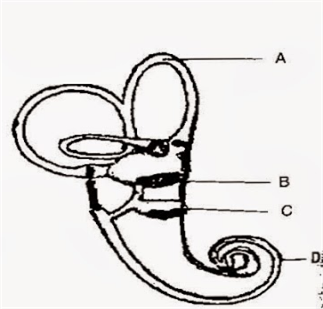
(i) Name the parts labelled A. B, C and D.
(ii) Name the part of the ear responsible for transm1tt1Dg Impulses to the brain.
(iii) Name the part labelled above which is responsible for
1. Static equilibrium
2. Dynamic equilibrium
3. Hearing
(iv) Name the audio receptor cells which pick up vibrations.
(v) Name the fluid present in the inner ear.
(a) The diagram below represents a surgical sterilization method in males. Study the same and answer the questions which follow: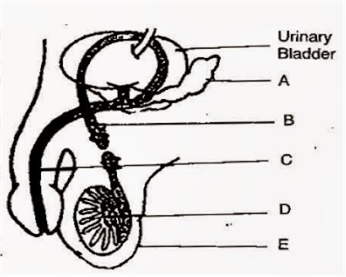
(i) Name the parts marked A. B, C, D and B.
(ii) Give the name of the surgical method represented in the diagram.
(iii) Which part is ligated or cut?
(iv) Name the corresponding surgical method conducted on females.
(v) Name the part which is ligated in females and why?The diagram below represents an experiment conducted to prove the importance of a factor in photosynthesis. Study the same and then answer the questions which follow:
(i) Name the factor being studied in this experiment?
(ii) Why was the plant kept in a dark room before conducting the experiment?
(iii) Why was the experimental leaf then kept in
1. boiling water; 2. methylated spirit?
(v) Name the solution used to test for the presence of starch in the leaf.
(v) What will we observe in the experimental leaf at the end of the starch test?
(vi) Give a balanced chemical equation to represent the process of photosynthesis.(i) The light factor is being studied in this experiment.
(ii) The plant was kept in a dark room to destarch its leaves. i.e. to remove all the starch present in the leaves of the plant.
(iii)
l. The leaf was kept in boiling water to kill the cells.
2. The experimental leaf was kept in methylated spirit to remove the chlorophyll.
(iv) Iodine solution
(v) The exposed parts of the leaf will turn blue-black, i.e. will show the presence of
starch, and the part covered with black paper will remain brown, showing the
absence of starch.
(vi) The process of photosynthesis:
Given below is a diagram depicting a defect of the human eye. Study the same and then answer the questions which follow: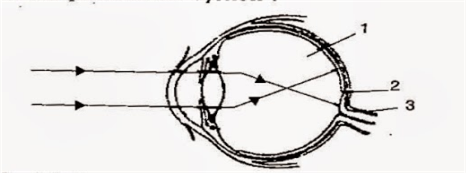
(i) Identify the defect.
(ii) Name the parts labelled 1, 2 and 3.
(iii) Give two possible reasons for this eye defect.
(iv) Draw a labelled diagram to show how the above-mentioned defect is rectified